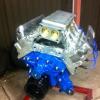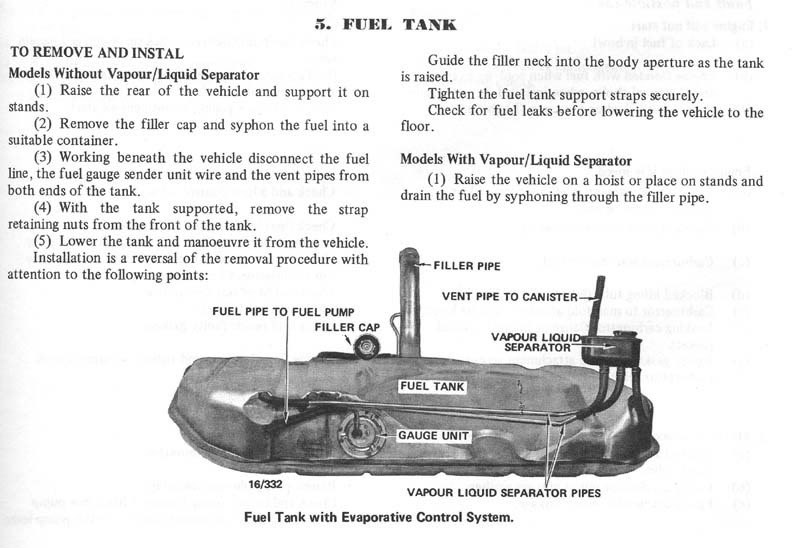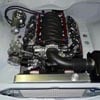
Vapour liquid Seperator lines
#1

Posted 05 May 2015 - 05:48 PM
Where do the vapour liquid Seperator lines connect to on a drop tank.
I have 2 breathers at the top of my tank which are located on each side of the tank.
#3

Posted 05 May 2015 - 06:59 PM
However I don't have a canister and my motor is injected.
#4

Posted 05 May 2015 - 07:51 PM
#5

Posted 05 May 2015 - 08:07 PM
I don't have a charcoal canister so can I also connect the top one to the breathers as well?
#6

Posted 05 May 2015 - 09:34 PM
The charcoal canister has no performance drawback and you probably need it legally anyway. Why not get a smaller one and hide it away somewhere?
#7

Posted 05 May 2015 - 09:34 PM
Even injected engines require a charcoal canister, the only time you don't is if your tank is vented to atmosphere and that hasn't been legal since the early 70's.
Regardless of how many vent tubes the tank has, all of them should go to the bottom of the vapour separator so any liquid can drain back to the tank, and the top of the separator is your tank vent so you can't loop it back to the tank or the fuel pump will create a vacuum and starve the engine for fuel.
#8

Posted 05 May 2015 - 11:33 PM
#9

Posted 06 May 2015 - 03:53 AM
I guess it would depend on the circumstances, if the vapour separator wasn't mounted high enough and you had the car on an incline (or possibly under heavy braking) with a full tank, then I suppose fuel would probably come out.
Normally you have a line running to the front of the car, to a charcoal canister which is mounted higher than the tank (so there's no chance of starting a siphon effect), and any liquid that accumulates in the line should get sucked back into the vapour separator anyway as the fuel pump draws fuel out of the tank.
But where else are you gonna run the vent line to if you don't have a canister? I reckon you'd get sick of the petrol smell pretty quick!
#10

Posted 06 May 2015 - 08:01 AM
Originally I was going to run a line from the vent to the filler neck.
#11

Posted 06 May 2015 - 08:13 AM
The filler neck option is still no good, it's more or less part of the tank which is sealed by the fuel cap.
Good luck tracking down the specific requirements with regard to which charcoal canister is needed, I was trying to confirm this myself but couldn't find anything official, I think it was mentioned somewhere that the size of the canister has to match the capacity of the engine?
If you're able to find any definitive information, please let us know!
#12

Posted 06 May 2015 - 08:25 AM
#13

Posted 06 May 2015 - 10:53 AM
#14

Posted 06 May 2015 - 12:01 PM
If you car has 27A on the compliance plate then you are required to run the charcoal cannister to comply with ADR 27A. The charcoal canister should suit the capacity of the fuel tank. Some engineers have specified two Torana charcoal canisters for a 120L drop tank. I have a VZ Monaro canister for my tank.
As other have said, the three breather pipes connected to the liquid vapour separator are to handle fuel expansion and vapour control. There is also a fourth filling breather running from the back of the tank to the filler neck.
The breather just to the left of the fuel sender in the picture below runs to the rear of the tank so when the car is parked nose down the two front breathers will be submersed but the third rear breather will be clear. The rear breather is typically missing on a drop tank. Running a line from the vapor separator to a Tee in the filler neck breather will be better than nothing.
The liquid vapour separator contains a float to which will close off the outlet to the charcoal canister if the vapor separator is unable to drain back into the tank and fills with fuel. If the front two breathers are are submerged due to the angle of the car and then when the fuel expands it will be pushed into the vapor separator and unable to drain back into the tank. At this point the pressure due to expansion should be released by the pressure control valve in the fuel cap.
The Price Engineering drop tank I had did not have the rear breather. If I filled the tank and then parked the car in the sun the fuel in the tank would expand and eventually force its way past the liquid vapor separator into the charcoal canister and then onto the ground instead of venting via the pressure control value in the fuel cap.
When I designed a new tank for EFI I included the rear breather. I also designed the tank to trap air pockets to allow for fuel expansion. The factory tank will trap air pockets to allow for fuel expansion however most drop tank designs do not.

You can see in the picture below that the rear breather has been cut through when the rectangular hole was cut in the top of the tank.

This is my fuel tank with the three breathers. I ran the breather on the passenger side of the tank over to the drivers side inside the tank so i did not need the external lines. The vapor separator has been moved to the drivers side.

Edited by ls2lxhatch, 06 May 2015 - 12:14 PM.
#15

Posted 06 May 2015 - 12:18 PM
The rear breather is typically missing on a drop tank, presumably because they were designed for the LH which did not have the rear breather, vapor separator and charcoal canister.
#16

Posted 06 May 2015 - 01:58 PM
#17

Posted 06 May 2015 - 02:17 PM
Just be wary of using a late model canister as the newer stuff is operated electronically by the ECU via a solenoid, whereas the older ones are controlled by vacuum. They do it that way so the computer can decide when the engine is ready to suck out the fumes, from memory it only happens once the engine is warmed up and running above idle.
If you're using the one off the donor car be sure to check whether it needs to be included in the wiring harness?
Edited by Bigfella237, 06 May 2015 - 02:17 PM.
#18

Posted 06 May 2015 - 02:52 PM
Canister has nothing to do with ADR27 or 27A. It was mandatory fitment from 1/75.
Holden may have fitted the canister from 1/75 but it was not an ADR until 1 July 1976. If it is not an ADR then it is not mandatory for a manufacturer.
ADR72A 1.4 and 1.5 basically required the fuel system to be sealed from the atmosphere.
ADR27A 1 July 1976
27A.1.4 'Fuel System' -means the combination of fuel tank, fuel pump, fuel lines and carburettor or fuel injection components, and includes all fuel system vents and fuel evaporative emission
control systems.
27A.1.5 'Fuel Evaporative Emissions' -means vaporised fuel emitted to the atmosphere from the fuel system of a motor vehicle.
https://www.infrastr...ign/pdf/27A.pdf
Edited by ls2lxhatch, 06 May 2015 - 02:54 PM.
#19

Posted 06 May 2015 - 03:44 PM
Incorrect. Canisters and sealed fuel system became mandatory from 1/75 when the chassis numbers changed from AHJ to BHJ (and probably ALH to BLH). It was independant of ADR27. You cannot legally register a BHJ car with a fuel tank or carby bowl vented to atmosphere - it must have a canister and sealed fuel tank and carby bowl.
#20

Posted 06 May 2015 - 04:26 PM
So what was the legislation that made Canisters and sealed fuel system became mandatory from 1/75?
#21

Posted 06 May 2015 - 04:34 PM
ADR 27, it reduced vapour emissions and a slightly cleaner idle.
#22

Posted 06 May 2015 - 04:38 PM
From NCOP
Additional Requirements for Vehicles fitted with Evaporative Emission Control Systems
• All of the fuel tank evaporative controls for ventilation of the tank must be installed and
operational to prevent hydrocarbon emissions entering the atmosphere;
• If the replacement fuel tank has a greater capacity than the largest optional fuel tank
available for the vehicle, an additional or larger canister of sufficient capacity must be
fitted to vehicles equipped with evaporative emission control systems; and
• Vehicles originally fitted with fuel tanks with expansion/vapour spaces must continue to
provide these facilities (e.g. modified fuel tanks must have vapour spaces proportional
to their new capacity). Vehicles originally equipped with independent liquid/vapour
separators must have either an additional separator or that provision built into the new
tank.
basically if the vehicle was made to comply with the ADR's it must continue to do so after modifications (with some extras),in the engine swap section it also says that the ADR's of donor vehicle's engine must be complied to even if the engine is going into a vehicle which did not have the ADR's of the vehicle that the engine came from.
EFI will need a return line to tank (unless already catered for),might be able to get away with a just teeing up both and running to canister?...last canister i looked at had a pipe that was fed through a hole into the inner guard/wheel area,so not exactly "sealed system" but the charcoal was the stuff that "collected" the vapor.
If the engine as suggested used an electronic switch to bleed the canister at operating temp. , that is not hard to do these days with very simple electrics
#23

Posted 06 May 2015 - 05:03 PM
So what was the legislation that made Canisters and sealed fuel system became mandatory from 1/75?
I'm not sure, but that is how they go. Dr Terry understands it better than me how it was introduced (I've seen him explain it before).
#24

Posted 03 June 2015 - 09:07 PM
Hey Guys,
I have finally connected up my fuel lines and put my tank back in.
I went to start it today and the motor turned half a turn and stopped.
I tried to spin it by hand and it would not move. It locked up,
I took out the plugs and turned the motor by hand and fuel started coming out of the cylinders.
I kept turning it by hand for about 5 turns till all the fuel came out and connected every back on.
Went to crank it again and it did the same thing. It locked up
Any suggestions on why it’s doing this would be great.
#25

Posted 03 June 2015 - 09:34 PM
A little more background info would be good, I think you said your motor was injected? What motor specifically?
If so what fuel rail pressure do you have? Does it hold or leak down fast when you cut the pump?
Is it all cylinders that are filling up or just one or two?
If it's not going through the injectors, is manifold vacuum sucking raw fuel through your tank breather setup?
1 user(s) are reading this topic
0 members, 1 guests, 0 anonymous users



 View Garage
View Garage














